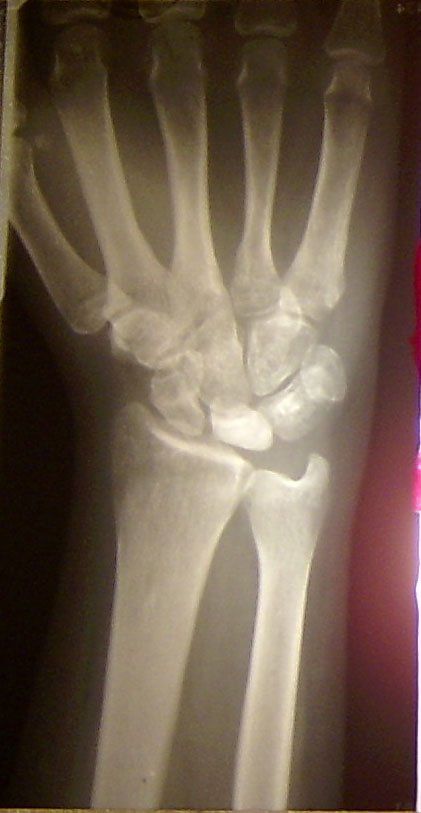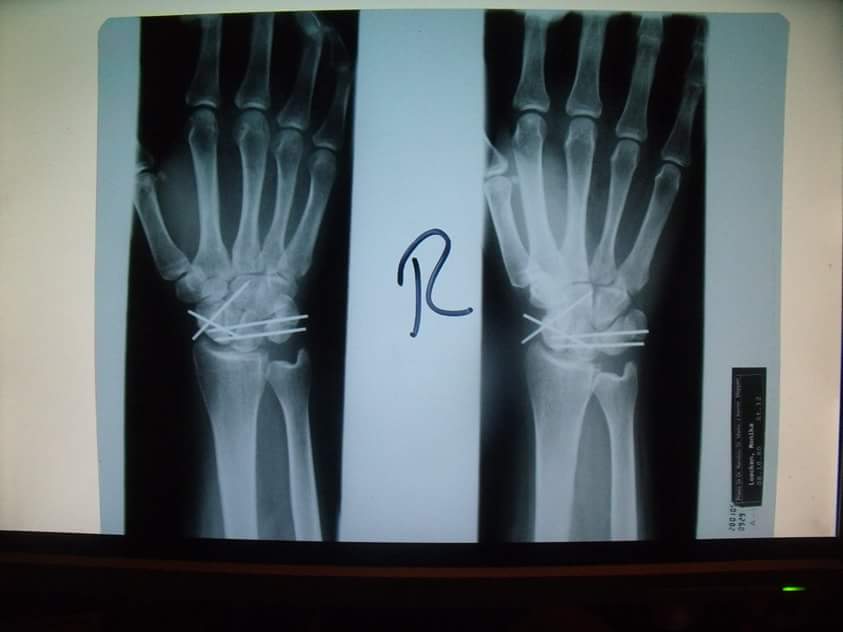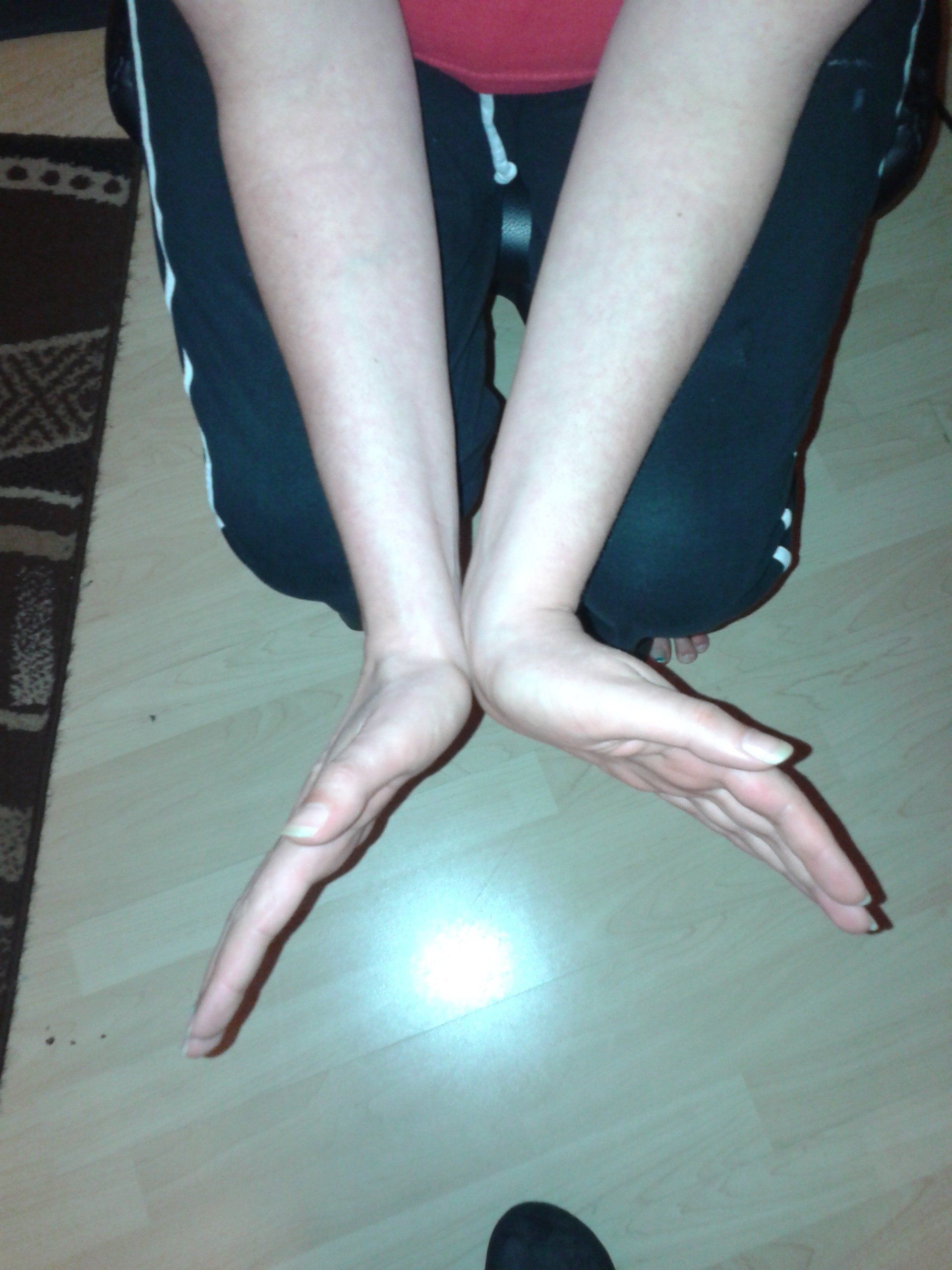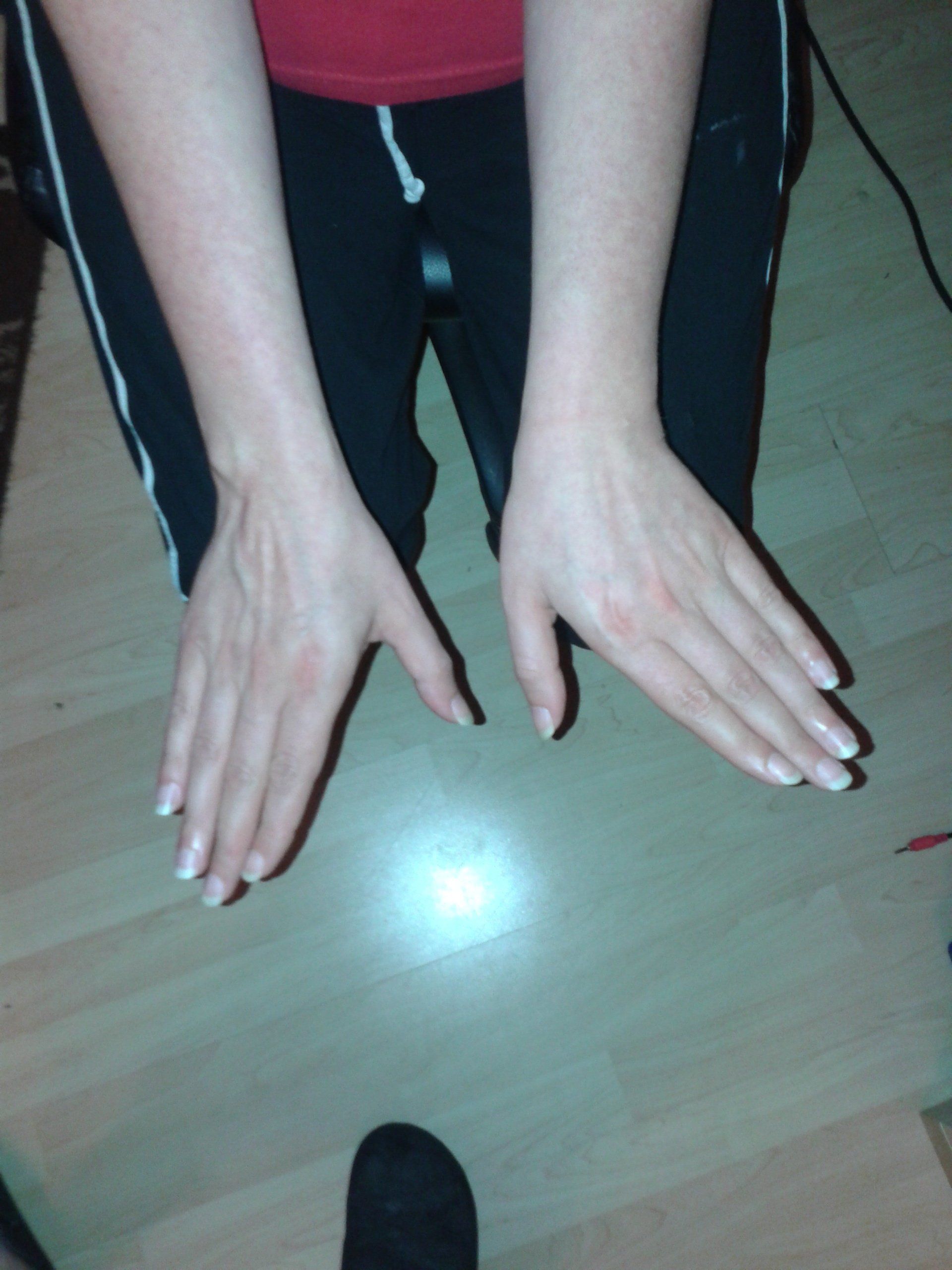Spongiosaplasty from iliac crest tendon interposition OP Graner 2 = partial stiffening / partial arthrodesis
Monika's course of illness
Since this page belongs to me, I don't want to withhold my course of illness from you either:
I myself have lunate malacia. In the meantime I have come to terms with the consequences very well and can do almost anything that I enjoy doing again. But it was a long and arduous road to get there. I do NOT want to arouse pity for the course of my illness - on the contrary! I would like to help others who have only recently been diagnosed with "lunate malacia", I would like to explain this so that all those who have problems with their wrist and are constantly being fobbed off with tendinitis, even though they may also have a diseased lunar bone, can get help and get help and I would also like to enlighten all those who, as soon as they hear that a bone is decomposing, think it is cancer, leukemia or the like: THAT IS NOT AS A rule!
History up to diagnosis of lunate malacia
I had the first complaints in the area of the wrist some time earlier - finding: "tendinitis" - that was at the beginning of my teaching. These complaints were over relatively quickly and therefore I cannot say whether the lunate malacia had already started at that time. I am currently (almost 19 years of age at the age of 18) doing an apprenticeship as a painter and varnisher. One day when I suddenly got pain on a construction site as soon as I wringed out even a sponge. Due to the situation at the time that the company had a lot of work and only 3 days left until the extended Easter weekend, I still worked. The pain increased from day to day and when I got home on the last day of work I needed a doctor's visit - my wrist was badly swollen, every movement caused a pain, as if someone were putting one nail after the other through it every second Wrist pounding.
Arrived at the doctor - and after about an hour of waiting - he looked at the presents with an almost gleeful grin and said that he had already warned me at the time that tendonitis was not to be trifled with. He then bandaged my wrist and wished me a "very nice and peaceful evening", gave me a recipe for ointment and added that I would certainly enjoy it.
I certainly had my joy. The painkillers, which were also available, no longer worked, the hand ached just as badly in the resting state as with any movement and I can only say: "I wouldn't even wish that on my worst enemy!".
After about a week and a half, the pain had largely subsided, except for the fact that I had to move, and I was supposed to make an attempt to work - after all, this referred to 1 hour after which I was allowed to go back to the doctor.
It went on like this for about 2 months. Because of the persistent pain and the fact that nothing worked, I switched to a sports medicine specialist and surgeon. He took an X-ray and couldn't find anything. Then he tried to blame it on gout and gave me the advice: "If you don't feel like doing your job, change it and don't play the sick!" Then I switched again - this time to my actual family doctor. Fortunately, after a few attempts he had tried with "current oscillations" (I don't know what they are called), he sent me to Dr. Gerwin, a sports doctor and orthopedic surgeon in Lingen, who immediately recognized the restriction of movement in the right wrist and had an MRI performed.
Lunate malacia - cancellous plastic from the iliac crest
The MRT brought the result "lunate malacia" and the referral to the hand surgeon Dr. Young. The lunate malacia was already in the II stage. A bone marrow transplant was thus performed. That meant about a week in hospital. I can calm down, the pain is not great and the restrictions from the operation are also limited. A plaster splint had to be worn for about 6 weeks after the operation. I quickly got used to dealing with it.
However, after the plaster splint was no longer necessary, the symptoms started. With the help of physiotherapy, the hand had to relearn how to perform movement sequences. It wasn't very painful either. However, one is limited in everyday life. It is difficult to open bottles, often do not think that you have been operated on and subconsciously get stuck on a door handle, a heater or other things that cause sudden movements and of course pain for a short time. It is depressing but only lasts for a certain period of time as the wrist continues to heal and after about 4 months it is forgotten.
However, after half a year I had complaints again. I could not continue to practice my teaching due to the lunate malacia. And after that time, the wrist pain started again with every movement. Another x-ray showed that the lunar bone had not regenerated and built up - as was actually planned - but rather decomposed. So another operation had to be performed.
Tendon interposition
In this operation, the deformed lunar bone was completely removed and replaced with a ball of tendons. During the operation, I had a partial anesthetic that only related to the arm. The operation was quite funny: At first the anesthesia of the right arm didn't want to work and 3 attempts were needed. Then I was taken to the operating room. I still felt every touch of the hand, which I said to the anesthetist when he asked how I was doing. His answer was: "Oh, that doesn't matter, the cut has already been made and the operation is also in full swing!" But I didn't notice anything and I couldn't see anything: - / but I immediately got to know the advantages and disadvantages of a telephone system including an Internet connection and then immediately knew that DSL was apparently very good. The doctors and the rest of the staff talked about this; -) After the operation, another 1 week hospital stay was announced. Then another 6 weeks of plaster splint and then again physiotherapy and the usual complaints after a recent operation on the wrist.
In the meantime the second operation was about 4 1/2 years ago. I am almost 24 years old and can use my wrist (almost) perfectly again. Except for potato peeling and similar work, as well as handicrafts, my wrist is resilient. And I am glad that I got to the doctors named under ADDRESSES. In the long term, it is likely that the wrist will have to be shut down - unless there are other ways and means in the meantime.
At this point I would like to encourage all those affected. Because as can be seen in the course of my illness, there is the possibility to live with it, not to completely change one's life. In the meantime, I've even been doing assembly line work without any problems for a period of time. But you have to keep one thing in mind: you must NEVER OVERLOAD OR UNDERLOAD the hand! You have to make the decision yourself what you are allowed to do and what not. You should NOT get cocky, but you should also not be too squeamish and careful with your wrist! And one thing is even more important: NEVER PUT YOUR HEAD IN THE SAND! (I had to learn that too - but it works !!!)
In this sense: Get well soon and carefully examine the findings and diagnoses of the doctors - it's better to ask 3 - 4 doctors than one ;-)
Your Monika
OP according to Graner 1 3/4 so 2 - fusion or also: the rescue
The lines above were written in mid-2004. Meanwhile, it is June 2005 and the LM "struck again". After I got along well enough, the movement and strain on the right hand had almost returned to a "normal state", the hand began to hurt again. At first only sporadically, then it got worse and worse.
I didn't really want to admit it and so it was easy at first to blame the pain on sensitivity to the weather.
Out of sheer frustration that I could not find a job despite my school education as a commercial assistant for business informatics, I made a spontaneous decision to set up my own business in the field of web design. I also worked in a pizzeria as a delivery driver, who also took orders and took care of all the work in the kitchen. In June or July 2004, while I was making preparations in the pizzeria kitchen, I stupidly slipped my knife and hit my right wrist, of all places. (Clumsy greetings ...) At first the wound looked worse than it was in the end, but - after all, it was the right hand that really caused me enough "trouble" ... - I went as a precaution to the doctor. In retrospect - with the "little scratch" - kind of ridiculous. Still, there may be a connection with the pain that will come later ... After all, it was a jerky affair. Fortunately, it didn't leave a scar. However, I can no longer say for sure when exactly the sporadic pain started, at least not too long after the incident.
At the end of October I started to think more about it. I had heard that my hand surgeon at the time was no longer on site. But I couldn't and didn't want to believe it. I tried several times to get an appointment by phone. When that didn't work out, I wanted to get a referral from my family doctor and then get an appointment there. But then my family doctor confirmed that the hand surgeon was really no longer on site. I didn't think that was nice ... From a friend who also has problems with her wrist, I found out that there was a new hand surgeon in Meppen. And since she had had a good experience, I made an appointment there. The only disadvantage: hand surgery within a hospital does not require a simple referral from the family doctor, but a referral from an orthopedic surgeon or surgeon who has his own practice. In addition, this meant asking former doctors for the documents that were on hand and the previous operations. I.a. also the old x-rays. After the lunate resection and tendon interposition in 2000, only a single x-ray was taken. And that was exactly what had disappeared ...
Before I went to the hand surgeon, I kept saying to myself: "If another operation is really necessary, don't shorten the radius." That was a thought I didn't like at all ... When I got to the hand surgeon, there was another doctor who looked at the documents and first of all sent me for an X-ray. When I got back, I got a little queasy when suddenly two doctors with serious faces stood in front of me. And when the word "radius shortening" was mentioned in general, I would like to be up and away straight away. But then I only got a referral to the MRT, which should provide further information. After the MRI, the "radiologist" who made the findings came to me again and asked, somewhat confused, whether I had already operated on my wrist. * smile * He must have been quite shocked when he couldn't find a moon bone ...
I couldn't smile anymore when he announced the preliminary result of the MRI: The tendon ball was almost completely "dissolved" and overall the architecture of the hand was no longer what it should be. That means, I realized at that moment that I had to "get used to" the idea that I would have another operation ahead of me. And while I was "looking forward" to clarity about the pain before the MRI, I was actually no longer in a hurry to go to the hand surgeon - the appointment was, however, so I had to.
I was suggested an operation according to Graner, in which the headbone should be divided into 2 parts, one of which should be placed in place of the moonbone and with spongiosa from the iliac crest the other part of the headbone should then be extended again. In addition, the option remained, depending on how the carpal bones, tendons, etc. looked in the meantime, to fuse the newly formed moonbone, headbone and the already tilting scaphoid bone (to bring them together, i.e. partial stiffening). The information was extensive and I was also informed about other surgical methods such as PRC and the advantages and disadvantages of these methods in my case were discussed. When asked whether such an operation had already been carried out there, I was honestly told that this was not the case. However, since the doctors were quite confident in the operation and I had confidence - and still have - from the preliminary talk, I agreed.
On January 27, 2005, the chief physician performed the operation himself. Before the general anesthesia, he, like his assistant senior physician, stopped by and asked how I was. When I was back in the room after the operation and still slightly "showered", the chief doctor came to tell me the result of the operation. The head leg was already attacked to a greater extent than it had previously appeared on the X-ray and MRI. The partial stiffening was carried out without complications. It was unusual for me that the plaster splint and the scar were on the outside of the hand. The previous operations had been performed from the underside, which was not possible with this operation. However, the pain was less than after the previous operations. I was in hospital for a total of 6 days (including the day of surgery and discharge). Despite the scar on the iliac crest, I was allowed to take a shower again while I was in hospital - with a plaster on the pool and a garbage bag around my arm - which I didn't know from the first operation in 1999 (at that time it was called "washing cats at the sink"). The nursing staff was also very nice.
I was discharged with two letters - one for the family doctor, one for the surgeon practicing outside the hospital. Together with the letter, it went to the family doctor, who later also pulled the strings. I had expected that he would refer me ... In short, the actual aftercare is still taking place regularly - and at my request - in the hospital with the hand surgeon who is operating. Even if I have a lot of confidence in my surgeon outside of it, I would not have been willing to have my hand re-treated in his care. I just think to myself that not too many different doctors should "fiddle around" with my hand. It is also said that "a lot of cooks spoil the broth" and when it comes to my hand I am sensitive and peculiar - if I have to, rebellious.
The Kirschner wires were removed on an outpatient basis after 6 weeks. After that there was no more plaster splint. Something I give high credit to the hospital: On the evening of the outpatient metal removal, the night nurse called my home to find out how I was feeling and again pointed out that - if anything should happen - I would call or come over there anytime could.
Regular x-ray checks were made, which sometimes showed that everything was healing well. I received physiotherapy after 6 weeks and occupational therapy was added later. Since June 5, 2005 I have been "healthy" again. Slight pain - especially after exertion - is still present. The restriction of movement is quite large compared to before, but these are all things that I can get used to and that I prefer a thousand times over than a completely stiff wrist.
Conclusion: I definitely do not regret the decision to have the operation performed. Of course, a better result would have been great. From the start I had the point of view: "It can't get worse, but there is a chance that it will get better". I also do not regret the decision not to seek any further opinion and to have placed my trust in the doctors. I can only hope, if something happens again in the distant future, that the doctors are still on site.
X-ray image after partial stiffening / fusion ...:
So this hurdle is over again and even if I used to like to hide my head in the sand, I am now optimistic again. I'm young - even if I'm still an "old box", that is, 25 this year. Sure, I would prefer I had a completely healthy hand and could do anything. Maybe I would have to reproach myself for having paid too little attention to the hand in the past 4 1/2 years without pain and with minimal restrictions and thus doing too much with it. But why? I live with this situation now and whether I am now wondering what would have happened if, the current situation is still the way it is ... Sometimes my hand annoys me, sometimes the "roller coaster ride" of the past few years annoys me and sometimes I'm a bit demotivated. In the physiotherapy practice I have read a saying that comes to mind again and again: "It is not important where the wind blows, it just depends on how we set the sails"
With this in mind, keep your fingers crossed that I can find a good job in view of the economic situation and keep your ears stiff and make the best of your situation. Everyone continues to get well soon.
Greetings Monika
PS: Now, in 2012, by the way, I'm over 30 and have been pain-free for over 7 years! Restrictions? Yeah, definitely, but I only notice it if I tried push-ups or something like that with my hand. You got used to it completely, only those who have no idea might look a bit stupid .. although, actually I don't even notice it :-) - And you kept your fingers crossed, I have a good job too ;-)













